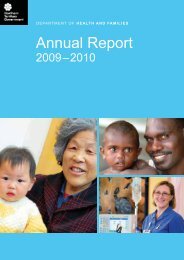PCD Strategy Evaluation 2007.pdf - NT Health Digital Library ...
PCD Strategy Evaluation 2007.pdf - NT Health Digital Library ...
PCD Strategy Evaluation 2007.pdf - NT Health Digital Library ...
You also want an ePaper? Increase the reach of your titles
YUMPU automatically turns print PDFs into web optimized ePapers that Google loves.
It was difficult to gauge the progress with improving Indigenous employment to report againstthe <strong>NT</strong> <strong>PCD</strong>S. Systems need to be established that set clear targets to increase capacity of thisimportant workforce and to monitor and report on those targets in the future. This will ensurethat there is a focus on actively recruiting and retaining indigenous workers at all levels of the<strong>NT</strong>DH&CS and as an essential part of the chronic care teams.6.7 Prevention and chronic disease programsA major gap identified throughout this evaluation of the <strong>NT</strong> <strong>PCD</strong>S process, was the capacity toprovide dedicated chronic disease and prevention programs. This is a function of both workforceskills development and the need for resources that are dedicated to this activity.Prevention and health promotion programs were identified as the highest priority by thestakeholders interviewed. Urban community health services identified health promotion andprevention as core business. However very few regional and remote services could identifysustained prevention and health promotion programs.The delivery of health promotion programs requires a distinct set of competencies and action isrequired to ensure that people with these skills are recruited, supported and embedded withprimary health care teams to ensure that the full range of primary health care services aredelivered in remote communities.Some ACCHOs participating in <strong>Health</strong>y for Life have established dedicated chronic diseaseprograms e.g CAAC and Wurliwurlijang. Most services reported that the acute care demands onservices prevented them dedicating staff to chronic disease activity. This is leading toinefficiencies and frustrations for other service providers. For example: the community physicianin Central Australia reported that she needed to complete many basic clinical activities, such asimmunisations, because of the lack of leadership on chronic disease care at the community level.In Katherine, ACCHOs identified difficulties with accessing allied health services. The only way toaddress these types of issues is to increase the number and mix of staff employed in, andvisiting, primary health care services to enable them to create the capacity to delivercomprehensive primary health care services.Chapter 6: Discussion – <strong>Evaluation</strong> of the <strong>NT</strong> Preventable Chronic Disease <strong>Strategy</strong> 2007 100
















